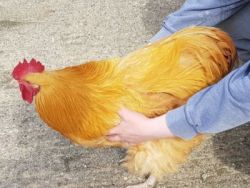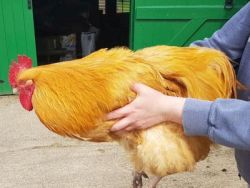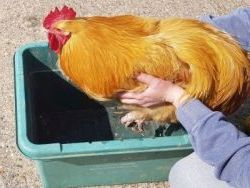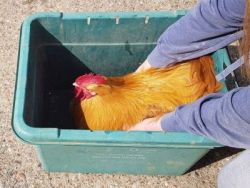In the guide
Although the United Kingdom left the European Union (EU) in 2021, certain pieces of legislation (known as 'assimilated law') continue to apply until such time as they are replaced by new UK legislation, revoked or permitted to expire. This means that our guidance still contains references to legislation that originated from the EU.
In this guide, the words 'must' or 'must not' are used where there is a legal requirement to do (or not do) something. The word 'should' is used where there is established legal guidance or best practice that is likely to help you avoid breaking the law.
This guidance is for England
Poultry are required to be handled and transported in a certain way. This includes safely carrying poultry, supporting them with both hands and ensuring that there is adequate space and ventilation.
When transporting poultry, only use vehicles that are fit for the purpose. The transporter is required to be authorised to transport poultry on journeys over 65 km, lasting up to eight hours (different rules apply for animals being transported for longer than eight hours). Drivers or attendants responsible for the transport of farmed poultry over 65 km must hold a valid certificate of competence. Journeys over 50 km require an animal transport certificate to be completed for each journey and kept for six months.
Handling and welfare
Below are some simple tips for better poultry handling.
1. Use both hands to keep the bird's wings secure against its body; apply a gentle but firm grip to prevent the bird from escaping or flapping its wings.

2. Ensure your hands, which are holding the bird's wings against its body, are placed in the middle of the body so you can hold the full weight of the bird and keep it level when carefully lifting it off the ground.

3. Keep the bird as level as possible, to reduce stress, when it is lowered down to be placed into a box or cage.

4. Make sure that help is at hand, in case you need assistance with any box lids, cage doors, etc. Ensure the bird is on the bottom of the box or cage before gently releasing your grip.

Note: a mesh top or similar must always be used on a solid-sided container to allow for ventilation.
This is the correct way to handle poultry at a market. Further advice is available from the Animal Health and Welfare inspector, if one is on duty at the market.
Poultry handlers must not:
- lift, carry or drag poultry by the head, neck, wing or tail
- tie or bind poultry by the neck, leg or wing
- use only one hand when catching, lifting and carrying poultry. You should always use both hands to support the bird
- carry poultry in a sack or bag. You must use only rigid containers with enough space and ventilation
- carry poultry head downwards
- transport poultry in containers with other types of livestock
- expose unfit poultry for sale
- cause suffering to poultry at any time
When transporting poultry, always remember that:
- poultry and other animals quickly overheat during warm weather in vehicles. Do not leave them in your vehicles as they could die. Failure to comply with this specific advice could result in prosecution for causing unnecessary suffering
- the means of transport should be designed, constructed, maintained and operated to avoid injury and suffering and ensure the safety of the animals
- rigid containers must be of a sufficient size, strength and design to prevent poultry from injury and unnecessary suffering while inside
- containers should always be carried upright. You should make sure that heads, legs and wings are unable to protrude
- receptacles must be labelled to indicate that they contain live birds and marked with a sign indicating each receptacle's upright position - for example, 'Live birds: this way up'
- containers must not be overcrowded, and you should avoid jolting or shaking them. Containers must be secured so as to prevent displacement
- containers must always have an adequate supply of fresh air
- when containers are loaded on top of one another, necessary precautions must be taken to limit urine and faeces falling on animals placed underneath
Holding birds by the legs
It is prohibited to catch, lift or carry birds of the species Gallus gallus (commonly known as chickens), and turkeys weighing 5 kg or less, by taking hold of or holding the legs, unless both of the legs are taken hold of or held at the same time.
If a turkey weighs more than 5 kg, it is prohibited to lift or carry it in an inverted position, whether by holding the bird by the legs or otherwise.
Back to topCommercial journeys
Anyone transporting poultry (journeys of 65 km or less are exempt) in connection with an economic activity must:
- on journeys over 65 km that take eight hours or less:
- have a short journey transporter authorisation (type 1) issued by Defra
- complete an animal transport certificate (ATC)
- be in possession of a certificate of competence (for drivers or attendants)
- on journeys over 65 km that take more than eight hours (defined as a 'long journey'):
- have a long journey transporter authorisation (type 2) issued by Defra
- have a valid vehicle / container approval certificate
- be in possession of a certificate of competence (for drivers or attendants)
- complete an ATC (unless a journey log is needed instead)
- ensure that contingency plans are in place in the event of an emergency
Note: a journey starts from a place where animals are first loaded and have been accommodated for at least 48 hours.
There are additional requirements relating to transporter authorisation, certificates of competence, vehicle / container approval and journey logs when transporting animals from the UK to EU Member States or through the EU to a non-EU country. The EU no longer recognises UK-issued versions of these documents. For more information, please see 'Transporting animals by road'.
For further details of the legal requirements relating to the transportation of animals, please contact the Animal and Plant Health Agency (APHA) on 0300 020 0301 or email WIT@apha.gov.uk.
Back to topSpace allowances
The space allowances given below are related to the density of poultry in containers. They are taken from Chapter VII of Annex I to assimilated Regulation (EC) No 1/2005 (see link in 'Key legislation' below), which also states: "These figures may vary depending not only on the weight and size of the birds but also on their physical condition, the meteorological conditions and the likely journey time".
| Weight (kg) | Area (cm2 per kg) |
|---|---|
| Day-old chicks (any weight) | 21 - 25 (per chick) |
| Less than 1.6 | 180 - 200 |
| 1.6 to less than 3 | 160 |
| 3 to less than 5 | 115 |
| More than 5 | 105 |
Further information
Some general information on catching, handling and transport can be found in Defra's codes of practice.
Keepers of poultry and most other captive birds are required to register their flocks. See 'Registration and records of poultry and other captive birds' for more information.
Back to topTrading Standards
For more information on the work of Trading Standards services - and the possible consequences of not abiding by the law - please see 'Trading Standards: powers, enforcement and penalties'.
Back to topIn this update
Added new requirements in the Welfare of Animals (Transport) (Amendment) Regulations 2025 (which amend assimilated Regulation (EC) No 1/2005) regarding holding certain birds by the legs.
Last reviewed / updated: July 2025
Back to topKey legislation
- Welfare of Animals at Markets Order 1990
- assimilated Regulation (EC) No 1/2005 on the protection of animals during transport and related operations
- Animal Welfare Act 2006
- Welfare of Animals (Transport) (England) Order 2006
Please note
This information is intended for guidance; only the courts can give an authoritative interpretation of the law.
The guide's 'Key legislation' links go to the legislation.gov.uk website. The site usually updates the legislation to include any amendments made to it. However, this is not always the case. Information on all changes made to legislation can be found by following the above links and clicking on the 'More Resources' tab.

